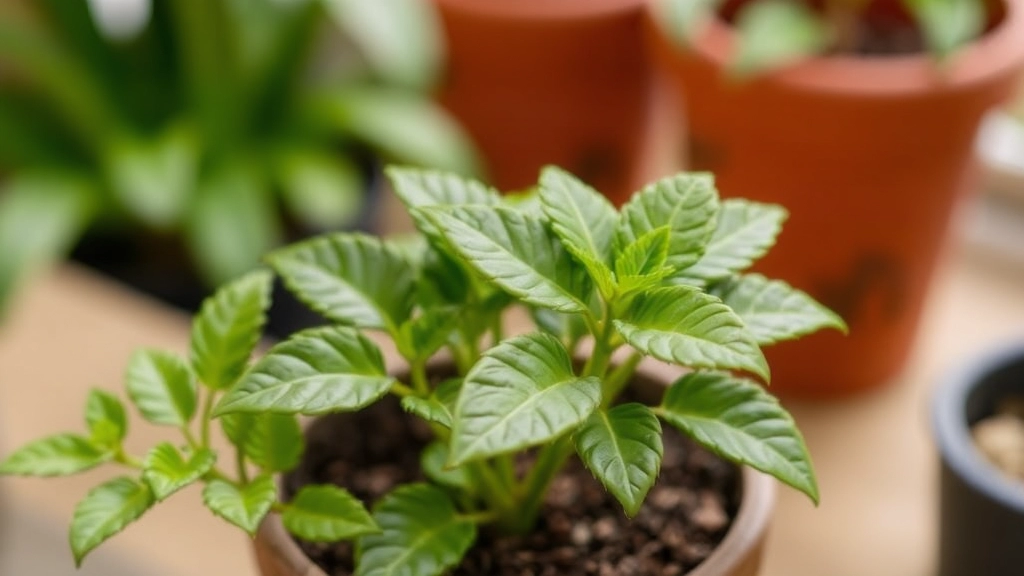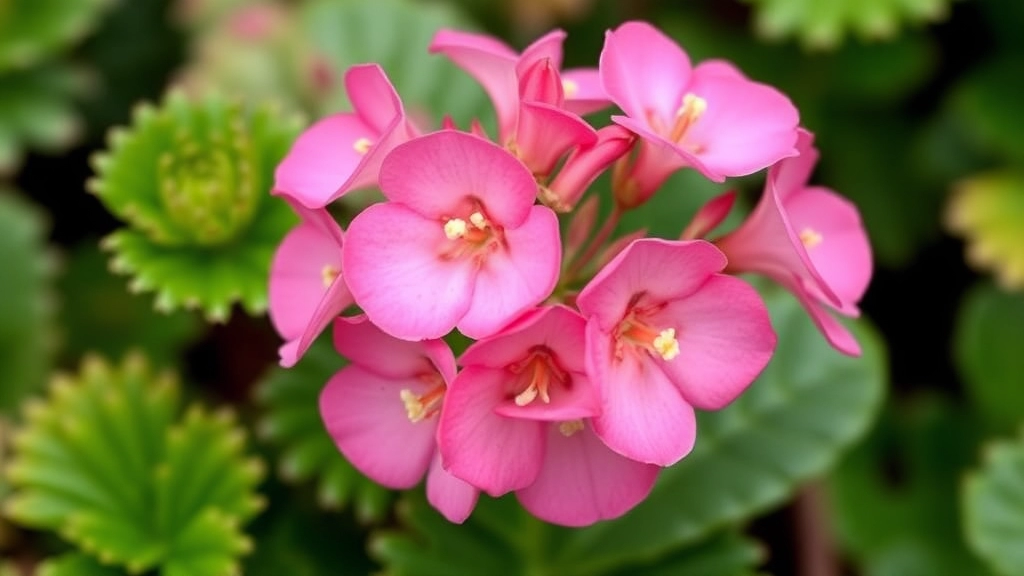Kalanchoe Mother of Millions Care
When it comes to Kalanchoe Mother of Millions care, finding the right balance is key. This unique plant thrives in bright, indirect light, making a sunny windowsill an ideal spot. Overwatering is a common mistake, so let the soil dry out between waterings to keep your plant healthy. Opt for a well-draining soil mix to prevent root rot.
Temperature and Humidity
Temperature and humidity also play a crucial role. Kalanchoe delagoensis prefers warmer climates but can adapt to indoor environments. Regular fertilization during the growing season will promote lush growth.
Propagation Tips
For propagation, simply use the plantlets that fall from the mother plant or cuttings. Keep an eye out for pests and tackle any issues promptly to ensure your plant remains vibrant and healthy.
When it comes to nurturing your Mother of Millions, the right location and light conditions are crucial. Many plant enthusiasts often worry about how to provide the ideal environment for their plants.
### Understanding Light Needs
Mother of Millions thrives best in bright, indirect sunlight. Here are some key points to consider:
– **Direct Sunlight**: While they can tolerate some direct sunlight, too much can scorch the leaves.
– **Indirect Light**: Placing your plant near a window where it receives filtered light is ideal.
– **Artificial Light**: If natural light is limited, consider using grow lights to supplement.
### Choosing the Right Location
The location of your Mother of Millions can significantly impact its growth. Here’s what to keep in mind:
– **Indoor Placement**: A south-facing window is often the best spot. Ensure it’s not too close to the glass to avoid heat damage.
– **Outdoor Conditions**: If you’re growing outdoors, select a location that gets morning sun and afternoon shade.
### Signs of Proper Lighting
How can you tell if your Mother of Millions is happy with its light conditions? Look for these signs:
– **Healthy Growth**: New leaves and plantlets indicate that your plant is thriving.
– **Leaf Colour**: Vibrant green leaves suggest adequate light, while yellowing may indicate too much direct sunlight.
For more tips on ensuring your plant thrives, check out this [Kalanchoe care guide](https://planthq.org/how-to-care-for-kalanchoe-succulent-expert-tips/). If you’re interested in exploring different varieties, you might find this [Kalanchoe species guide](https://planthq.org/explore-different-kalanchoe-species-for-your-garden/) helpful.
Watering Requirements and Soil Type for Optimal Health

So, you’ve got your Mother of Millions all set up, but how do you keep her thriving?
Watering and soil type are crucial for optimal health.
Watering Requirements
- Frequency: Watering depends on the season. During the growing season (spring and summer), I usually water every 1-2 weeks. In winter, you can stretch it to every 3-4 weeks.
- Signs of Overwatering: Yellowing leaves? That’s a red flag. If your plant is drooping, it’s time to check the soil.
- Signs of Underwatering: If the leaves are shrivelling or looking crispy, she’s thirsty!
Soil Type
- Well-Draining Soil: Use a mix that allows for good drainage. I like to use a cactus or succulent mix, but you can also create your own by combining regular potting soil with sand or perlite.
- pH Level: Aim for a slightly acidic to neutral pH (around 6.0 to 7.0). This helps the plant absorb nutrients effectively.
Quick Tips
- Check the Drainage: Make sure your pot has drainage holes. Standing water is a no-go!
- Watering Method: I prefer to water from the bottom. Place the pot in a tray of water and let it soak for about 30 minutes. This encourages deep root growth.
Temperature and Humidity Considerations for Indoor and Outdoor Growth
When nurturing your Mother of Millions, understanding temperature and humidity is crucial.
Fertilization and Nutrient Needs During Growing Season

As we delve into the crucial aspect of fertilization, it’s essential to understand how nutrients play a vital role in the overall health and growth of your Mother of Millions.
Understanding Nutrient Requirements
Mother of Millions thrives best when provided with the right balance of nutrients during the growing season. Here’s what to consider:
- Type of Fertilizer: Use a balanced, water-soluble fertiliser, preferably one with an N-P-K (Nitrogen-Phosphorus-Potassium) ratio of 10-10-10 or similar.
- Frequency: Fertilize every 4-6 weeks during the growing season, typically from spring to early autumn.
- Dilution: Always dilute the fertiliser to half-strength to avoid burning the roots.
Essential Nutrients
- Nitrogen: Promotes healthy leaf growth.
- Phosphorus: Encourages strong root development and flowering.
- Potassium: Enhances overall plant vitality and resistance to diseases.
Signs of Nutrient Deficiency
Keep an eye out for these signs to ensure your plant is receiving adequate nutrition:
- Yellowing Leaves: May indicate nitrogen deficiency.
- Stunted Growth: Could suggest a lack of phosphorus.
- Weak, Leggy Growth: Often a sign of insufficient potassium.
Additional Tips
- Organic Options: Consider using organic fertilisers like compost or worm castings for a natural nutrient boost.
- Soil Health: Regularly amend your soil with organic matter to enhance its nutrient-holding capacity.
How to Propagate Mother of Millions Through Plantlets and Cuttings
After understanding the essential care requirements for your Mother of Millions, it’s time to explore propagation methods that can help you expand your collection or share with friends.
Why Propagate?
Are you looking to create more plants from your existing Mother of Millions? This succulent is known for its ability to produce numerous plantlets, making propagation straightforward and rewarding.
Propagation Methods
Plantlets:
- The most common method involves the small plantlets that grow along the edges of the leaves.
- Steps:
- Gently remove the plantlets from the parent plant.
- Allow them to dry for a day to form a callous.
- Plant them in a well-draining soil mix.
- Water lightly until established.
Cuttings:
- If you prefer to use stem cuttings, this method is equally effective.
- Steps:
- Choose a healthy stem and cut it just below a leaf node.
- Let the cutting dry for a few hours to develop a callous.
- Place it in a pot with well-draining soil.
- Water sparingly until roots develop.
Tips for Successful Propagation
- Timing: Spring or early summer is ideal for propagation.
- Light: Ensure the new plantlets receive bright, indirect sunlight.
- Humidity: Maintain a slightly humid environment to encourage rooting.
By mastering these propagation techniques, you can easily multiply your Mother of Millions and enjoy their beauty in various locations. For more detailed guidance, check out our health and beauty benefits of Kalanchoe Mother of Thousands and our comprehensive care guide.
Pruning and Repotting Techniques to Maintain Plant Health

So, you’ve got your Mother of Millions thriving, but how do you keep it in tip-top shape?
Pruning and repotting are essential for maintaining the health of your plant. They can seem daunting, but trust me, it’s easier than it sounds!
Why Prune?
- Encourages Growth: Snipping off dead or yellowing leaves helps the plant focus its energy on new growth.
- Prevents Overcrowding: If your plant gets too bushy, it can become a breeding ground for pests.
- Aesthetic Appeal: Pruning shapes your plant, making it look neat and tidy.
How to Prune:
- Gather Your Tools: You’ll need clean, sharp scissors or pruning shears.
- Identify Problem Areas: Look for dead leaves, stems, or any leggy growth.
- Make Clean Cuts: Cut just above a leaf node to encourage new growth.
- Dispose of Debris: Remove any cuttings from the pot to prevent disease.
When to Prune:
Best done during the growing season, typically in spring or early summer.
Now, let’s talk about repotting.
Why Repot?
- Root Health: If roots are cramped, your plant can’t absorb nutrients effectively.
- Fresh Soil: New soil provides fresh nutrients and improves drainage.
How to Repot:
- Choose the Right Pot: Go for one that’s 1-2 inches larger in diameter.
- Prepare the New Soil: Use a well-draining cactus mix or potting soil.
- Remove the Plant Carefully: Gently take the plant out of its current pot, being careful not to damage the roots.
- Place in New Pot: Fill the bottom with soil, position the plant, and fill around it.
- Water Thoroughly: Give it a good drink to settle the soil.
When to Repot:
Every 1-2 years or when you see roots poking out of the drainage holes.
By keeping up with pruning and repotting, you’ll ensure your Mother of Millions stays healthy and vibrant.
Common Pests and Diseases: Prevention and Treatment
As we delve deeper into nurturing your Mother of Millions, it’s crucial to address a common concern: pests and diseases that can hinder your plant’s health.
Identifying Common Pests
Pests can be a real headache for indoor and outdoor plants alike. Here are a few you might encounter:
- Aphids: Tiny, soft-bodied insects that suck the sap from leaves, leading to yellowing and wilting.
- Mealybugs: White, cotton-like pests that can cluster in leaf joints and cause stunted growth.
- Spider Mites: Tiny arachnids that thrive in dry conditions, leaving behind webbing and speckled leaves.
Recognising Diseases
Diseases can also pose a threat. Keep an eye out for:
- Root Rot: Caused by overwatering, leading to mushy roots and plant decline.
- Powdery Mildew: A fungal disease that appears as a white powder on leaves, often due to high humidity and poor air circulation.
Prevention Strategies
Preventing pests and diseases is far easier than treating them. Here’s how:
- Regular Inspections: Check your plants weekly for any signs of pests or disease.
- Proper Watering: Avoid overwatering to prevent root rot. Ensure pots have drainage holes.
- Good Air Circulation: Space out plants to promote airflow and reduce humidity.
- Cleanliness: Keep your gardening area tidy to deter pests.
Treatment Options
If you do encounter pests or diseases, here are some effective treatments:
Ever looked at your Mother of Millions and thought, âWhy does it look so⦠sad?â
You’re not alone.
Let’s dive into some common growth issues that can pop up and how to tackle them head-on.
### Leggy Growth
If your plant seems to be reaching for the sky but has weak stems, it’s likely suffering from leggy growth.
This often happens when it’s not getting enough light.
– **Solution**: Move it closer to a light source.
– **Tip**: Rotate the plant regularly for even light exposure.
If you’re in a pinch, consider supplementing with a grow light.
### Overwatering
Overwatering is a sneaky culprit that can lead to root rot and a droopy plant.
If the leaves are turning yellow or mushy, it’s time to reassess your watering routine.
– **Solution**: Allow the soil to dry out completely between waterings.
– **Tip**: Use pots with drainage holes to avoid water accumulation.
Remember, less is more!
### Lack of Plantlets
So, you’re hoping for those cute little plantlets to sprout, but nothing’s happening?
This can be a sign that your Mother of Millions is not in its ideal environment.
– **Solution**: Ensure it’s getting enough sunlight and nutrients.
– **Tip**: Fertilize during the growing season to encourage growth.
If you’ve followed these tips and still see no plantlets, it might be time to check your [propagation methods](https://planthq.org/kalanchoe-leaf-propagation-stepbystep-guide/).
For more detailed advice on caring for your plant, you can also explore this [complete guide](https://planthq.org/kalanchoe-mother-of-thousands-care-complete-guide-tips/).
FAQs on Kalanchoe Mother Of Millions Care
What are the watering requirements for Mother of Millions?
Watering depends on the season. During the growing season (spring and summer), water every 1-2 weeks. In winter, you can extend it to every 3-4 weeks. Watch for yellowing leaves as a sign of overwatering and shrivelling leaves as a sign of underwatering.
What type of soil is best for Mother of Millions?
Use a well-draining soil mix, such as a cactus or succulent mix. You can also create your own by combining regular potting soil with sand or perlite. Aim for a slightly acidic to neutral pH (around 6.0 to 7.0).
How often should I fertilize my Mother of Millions?
Fertilize every 4-6 weeks during the growing season, typically from spring to early autumn. Use a balanced, water-soluble fertilizer with an N-P-K ratio of 10-10-10, and always dilute it to half-strength to avoid burning the roots.
What are the signs of nutrient deficiency in Mother of Millions?
Look out for yellowing leaves (may indicate nitrogen deficiency), stunted growth (could suggest a lack of phosphorus), and weak, leggy growth (often a sign of insufficient potassium).
Why is pruning important for Mother of Millions?
Pruning encourages growth by removing dead or yellowing leaves, prevents overcrowding which can attract pests, and enhances the aesthetic appeal of the plant.
How should I prune my Mother of Millions?
Use clean, sharp scissors or pruning shears to make clean cuts just above a leaf node. Identify and remove dead leaves, stems, or any leggy growth. Dispose of any cuttings to prevent disease.
When is the best time to prune Mother of Millions?
The best time to prune is during the growing season, typically in spring or early summer.
Why is repotting necessary for Mother of Millions?
Repotting ensures root health by preventing cramped roots and provides fresh soil that offers new nutrients and improved drainage.
How do I repot my Mother of Millions?
Choose a pot that’s 1-2 inches larger in diameter, prepare well-draining soil, gently remove the plant from its current pot, place it in the new pot, and fill around it with soil. Water thoroughly to settle the soil.
When should I repot Mother of Millions?
Repot every 1-2 years or when you see roots poking out of the drainage holes.
By following these guidelines, you’ll ensure your Mother of Millions remains healthy and vibrant.
References
-
Mother of Thousands Plant Profile
-
Mother of Thousands Care â How To Grow Kalanchoe Mother Of Thousands
-
Mother of Thousands: How to Grow and Care for Kalanchoe daigremontiana
